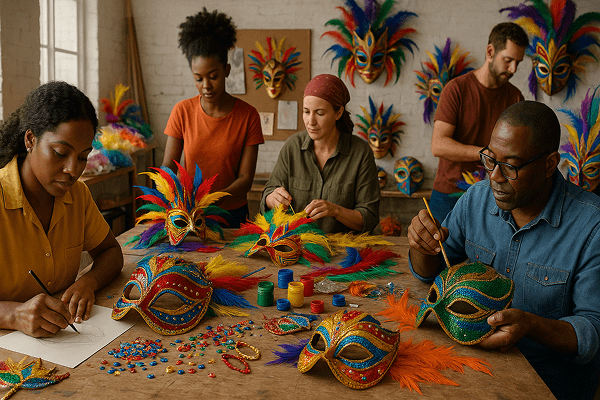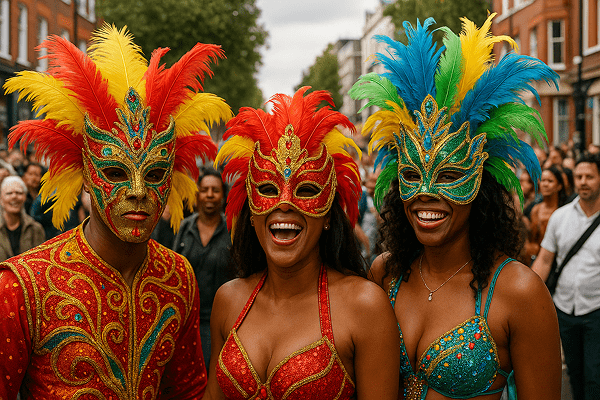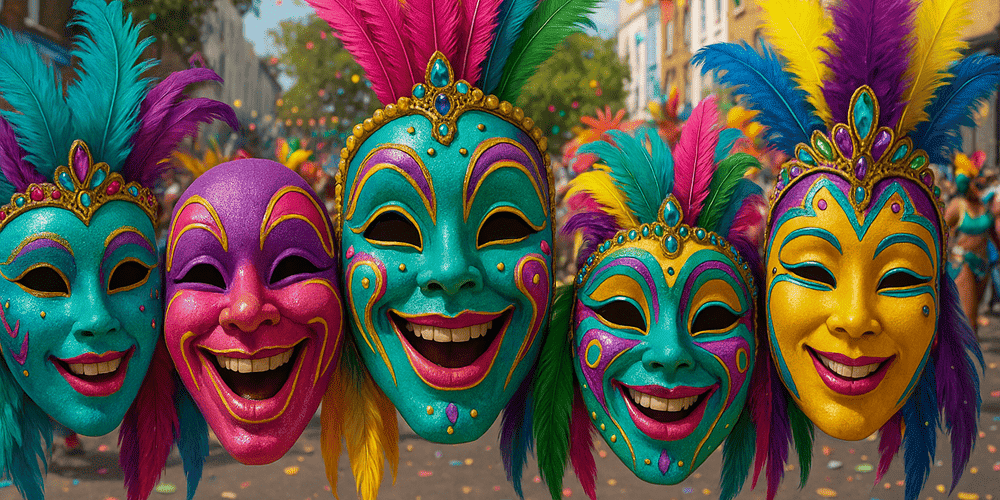Notting Hill Carnival Masks are vibrant, expressive, and deeply symbolic elements of one of the world’s largest and most famous street festivals — the Notting Hill Carnival in London. These masks are celebrated for their dazzling colors, bold shapes, and a unique blend of Caribbean, African, and European influences. Often adorned with feathers, sequins, metallic accents, and intricate beadwork, Notting Hill Carnival Masks are designed to be worn during the parade, dance performances, and street parties, adding an air of mystery, celebration, and social commentary to the festivities. Since the mid-20th century, these masks have become a powerful symbol of multicultural London, creativity, and resilience.
Historical Origins of Notting Hill Carnival Masks
The origins of Notting Hill Carnival Masks are rooted in the Caribbean masquerade traditions, particularly those of Trinidad and Tobago, Barbados, and Jamaica, brought to the UK by the Windrush generation and later Caribbean immigrants. The term “carnival” comes from the Latin “carne vale” (farewell to meat), linked to pre-Lenten festivities. The word “mask” is from the Latin “masca,” meaning ghost or spirit.
Notting Hill Carnival officially began in 1966, but the use of masks in Caribbean carnival goes back centuries, to African rituals, colonial resistance, and post-emancipation celebrations. Early Notting Hill masks were handmade from papier-mâché, fabric, or wire mesh, and often used in satirical performances and political protest. Over the decades, design and function have evolved — with influences from Brazilian, African, and European carnivals, as well as from pop culture and contemporary art. Important historical moments include the introduction of elaborate “Mas Bands,” which brought large-scale, thematically coordinated costumes and masks to the event.
Cultural Significance and Symbolism of Notting Hill Carnival Masks
Notting Hill Carnival Masks are rich with multicultural symbolism. In Caribbean tradition, masks have been used to mock colonial authorities, celebrate freedom, and honor ancestral spirits. In London, they symbolize both the city’s diversity and the resilience of its Black and Caribbean communities.
Spiritually, masks may represent deities, spirits, or mythological beings, serving as vessels for transformation and empowerment. Socially, they provide anonymity, enabling wearers to challenge norms, lampoon authority, and express political critique. Myths and legends — from African trickster gods to Caribbean folklore characters — are woven into mask designs, along with contemporary themes of migration, justice, and unity. The communal act of masking fosters solidarity, creativity, and celebration, making the mask a vital tool for cultural expression.
Materials and Crafting Techniques of Notting Hill Carnival Masks
Notting Hill Carnival Masks are crafted from a wide variety of materials, reflecting both tradition and innovation:
- Traditional materials: Papier-mâché, wire mesh, fabric, cardboard, beads, sequins, and feathers.
- Modern materials: Lightweight plastics, foams, metallic films, LED lights, and upcycled or recycled materials.
The process typically begins with sketching or sculpting the mask, building a frame (often from wire), and layering materials to achieve the desired shape. Artists use hot glue, sewing, painting, airbrushing, and collage techniques. Decorative elements such as feathers, rhinestones, and mirrors add sparkle and movement. Regional differences are seen in the choice of motifs, colors, and materials — with some artists favoring traditional Caribbean color palettes, while others experiment with avant-garde or eco-friendly designs. Color symbolism is central: gold and red for royalty and energy, green for hope, blue for peace, and black for ancestral memory.
For a closer look at mask-making techniques, interviews with artists, and galleries of Notting Hill Carnival Masks, visit toddmasks.com.

Functions and Uses of Notting Hill Carnival Masks
Notting Hill Carnival Masks are primarily worn during the two-day festival, which features grand parades, dance performances, and street parties. Their functions include:
- Ritual and ceremonial roles: Marking the opening and closing of the carnival, honoring ancestors or spirits.
- Theatrical application: Central to dance troupes, music bands, and performance art during the parade.
- Social and political critique: Used to lampoon authority, highlight social issues, and tell community stories.
- Decorative and artistic use: Many masks are displayed as art installations before or after the event.
The use of masks has shifted over time, from primarily handmade, protest-driven designs to more elaborate, themed, and artistically ambitious creations. Today, Notting Hill Carnival Masks are also used in exhibitions, educational workshops, and as collectible art pieces.
Regional Variations of Notting Hill Carnival Masks
While Notting Hill Carnival Masks are most closely associated with London, the designs reflect influences from:
- Trinidad and Tobago’s “Mas” tradition: Large, elaborate masks and costumes, often with historical or political themes.
- Jamaican Jonkonnu masks: Carved wooden faces, animal motifs, and devil figures.
- Barbadian Crop Over masks: Colorful, playful, and dance-oriented.
- African and Brazilian Carnival styles: Use of feathers, metallics, and symbolic animal imagery.
Each Mas Band in Notting Hill often develops its own unique theme and style, resulting in a dazzling diversity of mask designs. Comparing Notting Hill Carnival Masks to Colombian Carnival Masks reveals both shared Caribbean roots and unique local adaptations.
Famous Examples and Notable Collections of Notting Hill Carnival Masks
Some of the most iconic Notting Hill Carnival Masks have been featured in major exhibitions at the V&A Museum, the Museum of London, and the British Museum. Noteworthy examples include:
- Large animal and spirit masks from Mas Bands like Ebony, Yaa Asantewaa, and Bacchanalia.
- Political satire masks lampooning British politicians and global events.
- Historic protest masks from the 1970s and 1980s, reflecting the community’s struggles and victories.
Private collections and community archives often preserve masks from past carnivals, while contemporary artists and designers showcase their creations in galleries and online platforms. Toddmasks.com offers digital galleries and expert commentary on significant Notting Hill Carnival Masks.
Influence of Notting Hill Carnival Masks on Art and Culture
Notting Hill Carnival Masks have left a significant mark on British and global art, fashion, music, and literature. Their bold forms and expressive motifs inspire painters, sculptors, photographers, and costume designers. In literature, masks symbolize the complexities of identity, migration, and multiculturalism.
Music videos, theater, and fashion shows frequently incorporate carnival mask imagery, reflecting the vibrancy and resilience of London’s Caribbean communities. The ongoing celebration and reinvention of these masks play a vital role in preserving and transmitting cultural heritage.

Contemporary Status and Preservation of the Notting Hill Carnival Mask Tradition
Today, the tradition of mask-making for Notting Hill Carnival is alive and thriving. Master artists and new generations collaborate in workshops, community centers, and schools, blending traditional Caribbean techniques with digital design, eco-friendly materials, and performance technology.
Preservation efforts include museum exhibitions, oral history projects, and educational programs funded by local councils and cultural organizations. Annual competitions and artist residencies encourage innovation and foster community pride. Online resources such as toddmasks.com are central to sharing knowledge, connecting artists, and promoting the ongoing evolution of the carnival mask tradition.
Collecting and Acquiring Notting Hill Carnival Masks
Collectors can acquire Notting Hill Carnival Masks through direct commissions with artists, purchases from Mas Bands, at art fairs, and via reputable online platforms such as toddmasks.com. Prices vary widely, from affordable festival pieces to high-value, artist-signed works.
Key factors influencing value include:
- Artistic quality and originality
- Provenance and documentation
- Materials and craftsmanship
- Association with significant events or Mas Bands
Ethical collecting means supporting living artists, respecting cultural heritage, and ensuring transparent provenance. Toddmasks.com provides guidance on authenticity, valuation, and responsible collecting.
